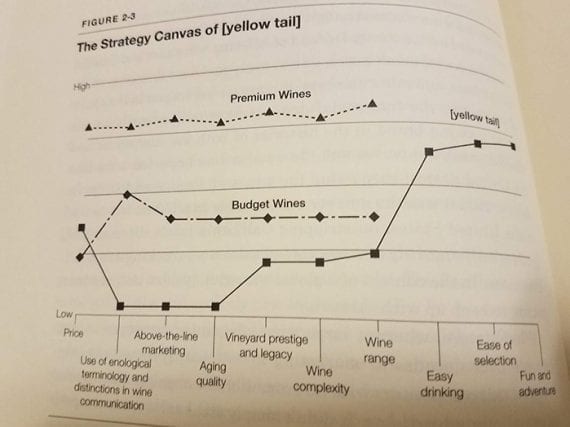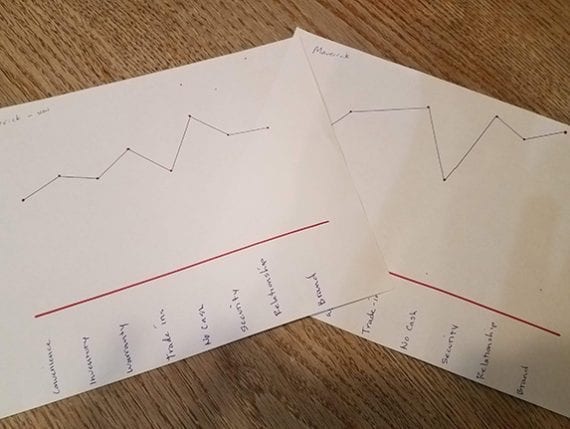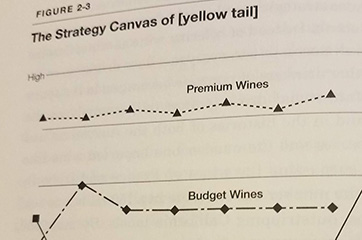The 2004 book, “Blue Ocean Strategy: How to Create Uncontested Market Space and Make the Competition Irrelevant,” describes markets as either red oceans, bloody from fierce competition, or blue oceans wherein a business can successfully sail toward growth and profitability without much competition.
The authors, W. Chan Kim and Renée Mauborgne, are world-renowned professors of business strategy. They wrote in the book that business strategists had “developed an impressive array of tools and frameworks to compete in red oceans,” but relatively tools existed for blue oceans. To address this imbalance, Mauborgne and Kim “studied companies around the world and developed practical methodologies in the quest of blue oceans.”
One of these methods is to employ a blue ocean strategy canvas. “The strategy canvas is both a diagnostic and an action framework for building a compelling blue ocean strategy,” Mauborgne and Kim wrote.
The Strategy Canvas
To draw a strategy canvas, a business leader should first identify the factors customers are likely to consider when choosing competing products. Think of these factors as product attributes or customer buying criteria.
In “Blue Ocean Strategy,” Kim and Mauborgne use the example of the U.S. wine industry in the 1990s, identifying factors such as price, above-the-line (mass media) marketing, and aging quality as established buying criteria.
These factors are often arranged in a perceived order of importance and are always positioned on the strategy canvas’s horizontal axis.

This photograph shows the strategy canvas for Yellow Tail wines taken from the book “Blue Ocean Strategy.”
The y or vertical axis represents performance or degree. Thus a high priced wine would have a dot high on this axis above “Price” while a budget wine would be relatively low on the vertical axis. A company or industry segment that invested a lot in marketing would, likewise, be high on the vertical axis.
Points positioned on the vertical axis are not supposed to be guesses. Rather where they are located should be related to marketing data, focus group results, or similar information.
The resulting graph shows the position of businesses or segments in the current marketplace — for example, premium wines versus budget wines.
Using this information, a business should next employ what Mauborgne and Kim call “the Eliminate-Reduce-Raise-Create grid.” This grid encourages business leaders to eliminate some of the buying factors, reduce some, raise others, and even create new ones to find a viable blue ocean market.
Thus “Blue Ocean Strategy” can help businesses identify market opportunities. But the strategy canvas can be misused — in a good way — to identify brand characteristics, resolve tactical conflicts, and help a business see itself from a customer’s perspective.
I’ll address those misuses in this post.
1. Identify Brand Characteristics
This first misuse comes in handy in the following scenario. Say you are in charge of marketing or brand strategy for a privately held, successful business that has been guided by a strong, charismatic leader or founder.
Ecommerce and marketing consultants or newly hired directors of marketing often find themselves in this position. The company’s brand and marketing strategy are embodied in its leader, and they may be hard to articulate. This leader may be focused on tactics rather than strategy. So it is difficult to know how she wants to position the company. Here is the solution.
- Describe in basic terms, the strategy canvas and how it can identify priorities.
- Ask the charismatic leader to describe the industry’s customer buying criteria.
- Ask the leader to draw a strategy canvas for her business based on those buying criteria. This is the current state.
- Next, have the leader draw strategy canvases for five competitors.
- Finally, ask the leader to draw a canvas that shows where she would like the business to be. This is the desired state.
Now compare the “current state” and “desired state.” In so doing, you will have identified which brand characteristics are most important to that leader.

A pair of strategy canvases showing the current state and desired state for a business.
2. Resolve Internal Conflicts
Imagine you are on the logistics team at a mid-market ecommerce business. You and your peers are arguing over the specifics of selecting and implementing a new pick-and-pull system. Some of your colleagues prefer a “this is how we have always done it” approach.
You need to transform this argument into a constructive conversation about capabilities. To achieve your end, you can misuse a strategy canvas.
- Define the services your department’s customers — internal and external — want. These are the factors on the x-axis.
- Next, plot each pick-and-pull option on the canvas based on your team’s collective expertise, discussing how each option performs relative to a given factor.
- Use the resulting canvas to identify which option is best.
The act of discussing and ranking the services you need with objective data can defuse the conflict.
3. Customers’ Perspective
The president of a multichannel merchant with physical retail stores, a growing online shop, and robust commercial sales decided to celebrate the company’s upcoming 60th anniversary. He wanted to divert a significant portion of the company’s marketing budget for the year to pay for special 60th-anniversary promotions.
This retailer’s marketing team believed it was a bad idea to take money from ongoing high-performing programs to pay for 60th swag and anniversary events.
To convince the company president, the marketing team conducted a few focus groups and surveys. Customers were asked to develop a strategy canvas to represent the retailer and its competitors. The process went something like this.
- Ask customers to define their buying criteria. If they don’t include something like “the company’s history,” encourage them to do so.
- Then have them draw a strategy canvas where the vertical axis represents the importance of each factor.
Compared to price, customer service, inventory selection, and location, a 60th anniversary was unimportant from the customers’ perspective. The strategy canvas proved it.







